Essential Insights on Hydroponic Plant Lighting
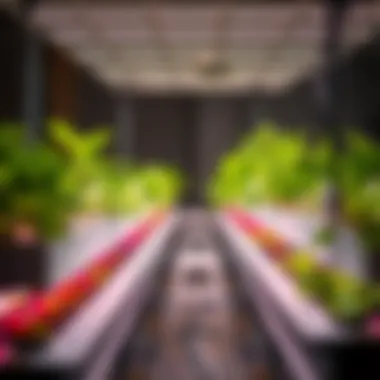
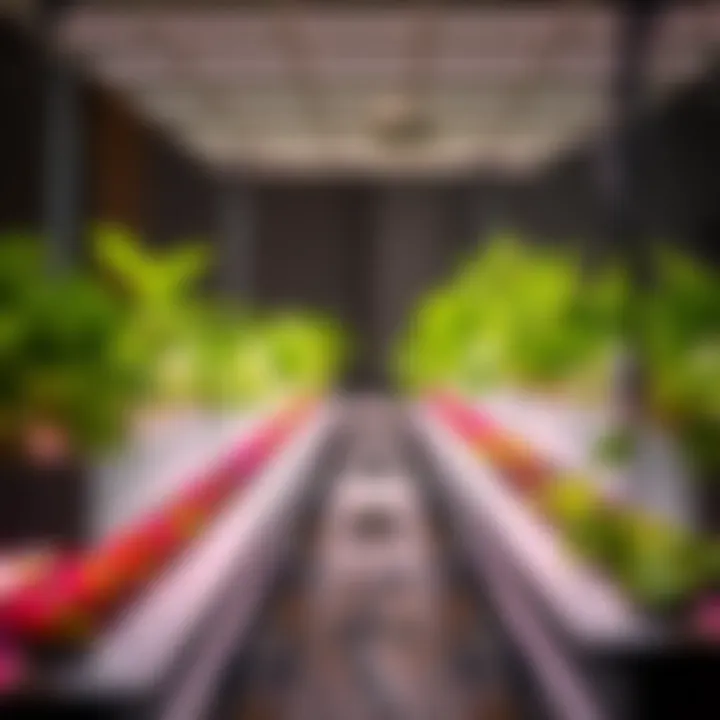
Intro
Effective plant lighting can make or break a hydroponic garden. Light is the lifeblood for plants, dictating not just growth rates but also health and productivity. In hydroponics, where soil is absent, the right light sources become even more critical. Whether you are a seasoned hydroponics expert or a curious newbie, understanding how to harness lighting effectively is essential. This guide will unpack various facets of plant lighting, illuminating the path (pun intended) for growers eager to optimize their systems.
In the coming sections, we will explore what plant lighting involves, its significance, and how it has progressed over the years. We will then segue into techniques and innovations that are reshaping hydroponic practices today before rounding things out with practical applications that will give you a tangible sense of how to implement these insights in your own garden.
Prologue to Hydroponics and Lighting
The delicate art of hydroponics is nothing short of revolutionary in today’s agricultural landscape. At its core, hydroponics involves growing plants without soil, using nutrient-rich water instead. This practice presents a unique opportunity to cultivate a wide variety of plants all year round, regardless of the external environment. However, the key to success in any hydroponic system hinges significantly on one factor: lighting.
Defining Hydroponics
Hydroponics is quite simply a method of growing plants in a soilless environment, often utilizing a nutrient solution to deliver essential elements directly to the roots. This process can take many forms, from floating rafts to nutrient film techniques, each with its own unique benefits and challenges.
Unlike traditional farming—where multiple variables such as soil quality, weather, and pests come into play—hydroponics enables a more controlled environment. The ability to regulate every aspect of growth, from temperature to moisture, gives growers the upper hand. With this method, it’s possible to achieve faster growth rates and higher yields. Not to mention, it reduces the necessity for pesticides and herbicides, making it an environmentally friendly option. It’s essential for those interested in stepping into this field to have a clear understanding of what hydroponics entails before diving in.
Importance of Lighting in Hydroponic Systems
Now, when engaging in hydroponics, lighting should not be an afterthought. It plays a pivotal role not only in energy consumption but also in the overall health and productivity of plants. Without adequate lighting, even the best nutrient solutions can’t ensure optimal growth. What growers need to recognize is that plants depend on light—specifically certain wavelengths—to drive photosynthesis, the process that fuels their growth and development.
Here are some reasons why effective lighting is paramount:
- Photosynthetic Needs: Plants primarily utilize the light spectrum for photosynthesis; thus, adequate lighting directly affects growth, flowering, and fruiting.
- Growth Stages: Different plants have varying lighting requirements based on their growth stages—whether they are seedlings, in vegetative growth, or flowering.
- Energy Efficiency: Efficient lighting not only promotes plant health but can also save energy, reducing costs in the long run.
With this in mind, as we look closer at the systems and types of plant lighting available, it’s crucial to consider how proper illumination can also enhance the hydroponic experience. The right lighting selections enable growers to harness nature’s magic efficiently, allowing plants to flourish irrespective of environmental constraints.
Proper lighting is to hydroponics what water is to traditional farming—without it, success is unlikely.
In the sections that follow, we will delve into the various aspects of plant lighting, exploring types of grow lights, their specific roles, and strategies for efficient lighting in hydroponics. Understanding these elements enriches the foundation for building a successful hydroponic environment.
Fundamentals of Plant Lighting
Understanding the fundamentals of plant lighting is crucial for anyone venturing into hydroponics. Lighting does not simply illuminate a grow space; it plays a pivotal role in the overall health and productivity of the plants. Adequate lighting mimics the natural environment plants need to thrive, driving photosynthesis and influencing various growth processes. Whether you're a novice gardener starting with simple setups or an experienced grower looking to refine your methods, grasping these essentials is the foundation of a successful hydroponic system.
Light Spectrum and Plant Growth
The light spectrum encompasses a range of wavelengths that plants utilize for photosynthesis, which translates to their growth and yield. Understanding how different wavelengths contribute to plant development can significantly influence decision-making when setting up lighting systems.
Photosynthetically Active Radiation (PAR)
Photosynthetically Active Radiation, or PAR, is a specific range of light wavelengths that plants can use for photosynthesis, generally measured between 400 to 700 nanometers. One primary reason PAR is celebrated is its direct impact on plant growth; it facilitates the conversion of light energy to chemical energy. Plants, much like the seasoned leaders in a boardroom, have specific 'preferences' for this range.
A standout characteristic of PAR is its effectiveness in fueling the metabolic processes of plants. It helps trigger blooming in flower-inducing species, allowing gardeners to see returns on their efforts. In hydroponics, using lighting options that maximize PAR can be a game changer, leading to enhanced growth rates and healthier plants.
However, it's not all sunshine and rainbows. Some lighting options might not emit enough PAR, leading to stunted growth and wasted resources.
Wavelength Ranges and Their Effects
Wavelength ranges extend beyond the simple dichotomy of light and darkness; they provide rich insight into how each color influences plant behavior. For instance, blue light, falling between 450-495 nanometers, is essential for leaf development and vegetative growth. In contrast, red light, around 620-750 nanometers, is critically tied to flowering.
One vital takeaway is how the balance of these wavelengths affects overall yield. A grower might discover that having a higher proportion of blue light during growth stages encourages denser foliage, whereas adjusting the spectrum to favor red light during flowering can optimize bloom quality.
The unique feature here involves understanding that not all lights equal efficiency in all scenarios. Some growers might lean too heavily on one spectrum at the expense of another, leading to a shadow of disappointment in their final yield.
Photoperiodicity in Plants
Plants also rely on light duration, known as photoperiodicity, to prompt specific growth stages. It's like a clock that governs their lifecycle. Just as some folks slog through work during the day while others come to life when the sun sets, plants respond differently to various levels of light exposure.
For instance, many flowering plants require periods of darkness in a day. This critical interplay of light and darkness must be considered when designing hydroponic systems. Successfully managing photoperiodicity can unlock the full potential of crops, allowing for sequential planting and continual harvest cycles.
Types of Grow Lights
The type of grow lights you select plays a crucial role in hydroponic gardening. Different plants have distinct light requirements, and knowing which type of grow light to use can considerably affect your results. Below, we will explore various types of grow lights, along with their unique advantages, disadvantages, and applications tailored for hydroponics.
Incandescent Lighting
Advantages and Disadvantages
Incandescent lights have been around for ages, and while they are often seen as the old guards of artificial lighting, they do come with some notable merits and drawbacks.
Advantages:
One primary advantage is their cost-effectiveness. They are generally cheaper to purchase compared to other lighting options. It might not break the bank at the start. They also offer a warm light that can help with plant aesthetics, making them visually pleasing in a home setup.
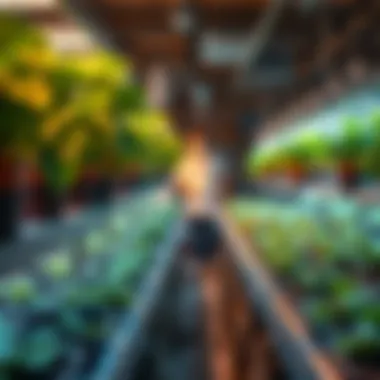
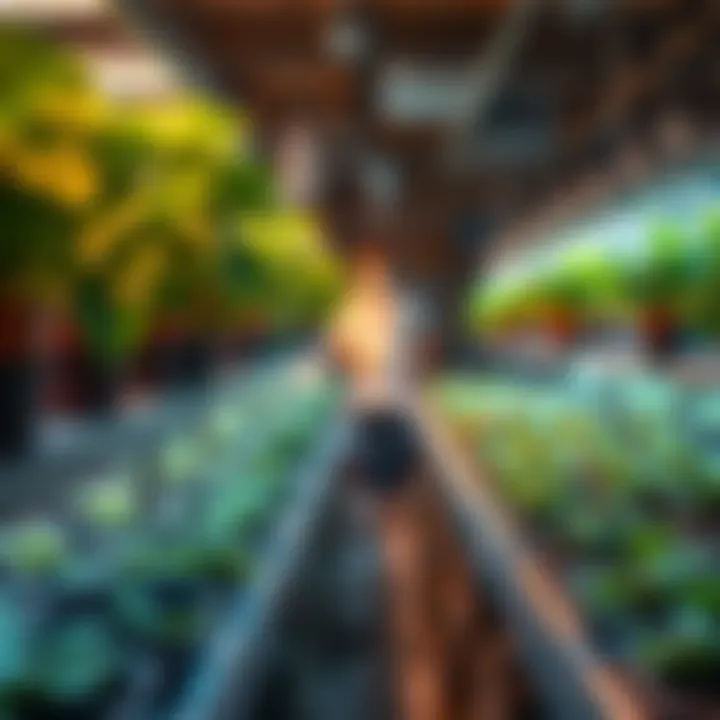
Disadvantages:
On the flip side, incandescent lights emit a lot of heat, which can stress plants if not managed properly. Moreover, they are energy inefficient, consuming more electricity while providing less light. As a result, they are not ideal for serious hydroponic growers looking to maximize their yield.
Application in Hydroponics
When it comes to application, incandescent lights do have their place, albeit a limited one. They can be beneficial for nurturing young seedlings or for providing additional light during shorter days.
Unique Feature:
One unique feature is their ability to be dimmed without affecting light quality, which allows for some flexibility in light intensity. However, their low overall light output makes them more of a supplementary light rather than the primary source in most hydroponic systems.
Fluorescent Lights
Types of Fluorescent Lights
Fluorescent lights have garnered popularity among hydroponic enthusiasts for their efficiency and spectrum availability. They come in various forms, such as T5, T8, and compact fluorescents.
Key Characteristic:
T5 lights, in particular, are favored due to their high output and lower heat production. This makes them ideal for densely packed hydroponic setups, where avoiding overheating is crucial.
Advantages/Disadvantages:
While they emit less heat than incandescent lights, fluorescent lights are still not as energy-efficient as LEDs. They also have a shorter lifespan than some other options, which could lead to more frequent replacements over time.
Best Uses in Hydroponic Systems
Fluorescent lights excel in seedling and vegetative growth phases. Their broader spectrum allows for viable growth without too much energy consumption.
Unique Feature:
A distinct aspect of fluorescent lights is their ability to be positioned close to plants without risk of heat damage. This feature enables you to maximize light exposure without burning delicate leaves, thus enhancing healthy growth.
Light Emitting Diodes (LEDs)
Advantages of LEDs
LEDs are replacing many traditional grow lights due to their energy efficiency and tailored light spectrums. Their specific wavelengths can be customized to favor various growth stages, from seedling to flowering.
Key Characteristic:
One of the standout traits of LEDs is their longevity. Unlike incandescent bulbs that often burn out quickly, LEDs can last for years, making them a smart investment for passionate hydroponic enthusiasts.
Advantages/Disadvantages:
Furthermore, they convert a higher percentage of electricity into usable light, pushing down electricity bills. Still, they tend to have a higher upfront cost, which could be a deterrent for beginners.
Choosing LED Spectrum for Hydroponics
Choosing the correct LED spectrum is vital for optimizing plant health. Different cycles of growth require different light spectrums. For instance, during the vegetative phase, plants thrive under blue light, whereas red light is better for flowering.
Key Characteristic:
A major benefit of LEDs is their ability to mix different wavelengths in one light fixture, offering versatility according to the plants’ needs.
Advantages/Disadvantages:
However, selecting the right spectrum can be tricky for newcomers, as confusion in the spectrum could lead to suboptimal growth. To narrow it down, it's advisable to look for products specifically designed for hydroponics and read reviews from fellow growers.
High-Intensity Discharge (HID) Lights
Types of HID Lighting
HID lights are often considered a powerhouse in the world of grow lights. They produce an intense and focused beam of light, useful for many hydroponics systems. There are primarily two types: Metal Halide (MH) and High-Pressure Sodium (HPS).
Key Characteristic:
MH lights are favored during vegetative stages due to their cooler, blue hues, while HPS lights shine during flowering phases, as the warmer spectrum boosts yield significantly.
Advantages/Disadvantages:
While HID lights can drive impressive growth, they necessitate additional considerations like effective heat management and adequate ventilation to prevent overheating.
Hydroponic Suitability
The suitability of HID lights for hydroponics is largely recognized. Their impressive lumen output can foster rapid plant growth, given that proper heat dissipating measures are implemented.
Key Characteristic:
A unique aspect is their ability to draw more energy, both in electrical needs and cooling requirements.
Advantages/Disadvantages:
This could mean higher operational costs due to power use and the necessity of supplemental cooling setups. So while HID lights can yield impressive harvests, they may require a more experienced hand to manage effectively.
Strategies for Effective Lighting in Hydroponics
In the realm of hydroponics, the strategies employed for effective lighting can mean the difference between a thriving garden and a struggling one. It's not simply about having a bunch of lights but understanding how to utilize them at every stage of plant growth. This section delves into the key components of light duration and the optimal positioning of grow lights. Doing this not only boosts plant health but also increases yields, making it invaluable for both novices and seasoned growers alike.
Determining Light Duration
Plants don't just need light; they need the right amount at the right time. Managing light duration is a crucial strategy in hydroponic systems, as it directly influences growth phases and overall health of the plants.
Seedling Stage Lighting
During the seedling stage, it's imperative to provide gentle yet sufficient light. This stage typically lasts for the first couple of weeks post-germination. The key characteristic of seedling stage lighting is its lower intensity compared to later stages, which helps prevent damage to the young plants. Using fluorescent lights or soft LEDs works wonders here.
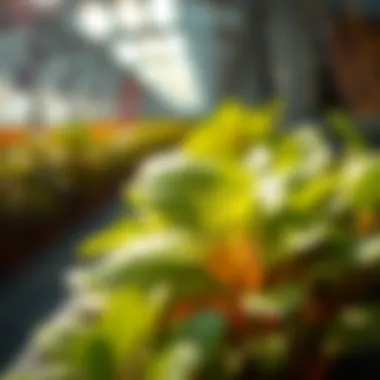

One of the unique features of maintaining light duration at this stage is the ability to use shorter photoperiods, around 12 to 14 hours a day. This fosters strong root systems without stressing the plants too much. The advantage is clear: young plants develop in a controlled environment, minimizing the risk of leggy growth, which often happens under too much direct light. However, be aware that insufficient light can lead to poorly developed seedlings, making this balance crucial.
Vegetative Stage Lighting
As plants progress to the vegetative stage, their lighting requirements change significantly. At this point, a more intense light source becomes essential. The characteristic of vegetative stage lighting is not just its brightness but also its consistency. A light duration of 16 to 18 hours is commonly recommended.
This consistent exposure encourages lush foliage development, which is crucial for future flowering stages. A unique aspect of the vegetative stage is the integration of different light spectrums. Using a mix of blue and red light promotes robust growth, making it a favored choice among growers. The downside? Higher energy consumption. Nonetheless, the trade-off is often worth it for the healthier plants and better yields.
Flowering Stage Lighting
The final growth phase, flowering, demands another switch in lighting strategy. During this phase, the light spectrum shifts towards more red wavelengths, aligning with plants’ natural responses. Typically, the lighting duration is reduced to about 12 hours per day to simulate the natural seasonal changes plants experience.
The key characteristic here is to trigger the flowering hormones within plants, essential for producing fruits or blooms. The unique feature of flowering stage lighting is its capacity to enhance not only the quantity but also the quality of the yield. However, growers should be careful, as improper light could lead to stress, causing issues like delayed flowering or poor fruit set.
Light Distance and Coverage
It's not just about having the right lights; how they are positioned in relation to the plants matters immensely. Proper light distance and coverage strategies are vital for ensuring that every plant receives adequate illumination without burning them out.
Optimal Light Placement
Finding the best spot to place your grow lights can make or break a hydroponic system. This aspect involves understanding the adequate distance from the plants based on the type of lighting used. For instance, LED lights can often be placed closer, usually about 12 to 18 inches above the canopy, compared to HID lights, which typically require a distance of 24 to 36 inches.
The key characteristic of optimal light placement isn't just about distance but also about the uniformity of coverage. When done correctly, plants grow evenly, minimizing competition for light. It’s an effective method that enhances photosynthesis efficiency, ultimately reflecting positively in the harvest. However, be wary of inconsistent placement leading to uneven growth and lighting hotspots.
Adjusting Light as Plants Grow
As your plants evolve, their lighting needs will shift. Adjusting light as plants grow is all about flexibility and responsiveness. Regular monitoring of both plant height and light intensity becomes necessary as they climb.
The unique feature of this strategy is its proactive approach. By gradually increasing light intensity or altering the height of your lights, you can ensure that plants receive the optimal conditions they need to thrive. The downside? Frequent adjustments can be labor-intensive. However, the result of a well-managed light system can lead to a bumper crop.
Overall, understanding the nuances of these strategies allows growers to harness the light in a manner that nurtures their plants, making every effort worthwhile in their hydroponic journey.
Environmental Factors Affecting Lighting Efficiency
The effectiveness of lighting in hydroponic systems doesn’t solely hinge on the types of grow lights being used, but also on several environmental factors that can significantly influence their performance. Understanding these factors can not only enhance the efficiency of light usage but also lead to healthier plant growth and better overall yields. When we talk about environmental aspects, we mainly think of temperature, humidity, and air circulation—transforming these elements into optimal conditions can make worlds of difference in your hydroponic endeavors.
Temperature Control
Temperature is a biggie when it comes to plant welfare in hydroponics. The right temperature supports photosynthesis, respiration, and metabolism, all of which are critical for robust growth. If temperatures swing wildly, it can lead to chaos in your plants’ behavioral patterns.
- Optimal Temperature Range: Generally, most crops prefer a cozy range between 65°F to 75°F (18°C to 24°C) during the day, and a tad lower at night. Too high, and we risk stress; too low, and growth slows down to a crawl.
- Excessive Heat: If the grow lights pump out too much heat, especially in confined grow areas, you can cook the plants. Look for signs of wilting or burnt leaf tips, as these can signal distress.
- Cooling Techniques: Some growers utilize fans to circulate air or even chillers to maintain a stable temperature. Focusing on venting out hot air can keep conditions just right.
A stable temperature isn’t just a luxury; it is a necessity for the health of your hydroponic plants.
Humidity and Airflow Management
Humidity and airflow go hand in hand in ensuring your plants are not just surviving but thriving. Managing humidity levels is especially important in hydroponics due to the absence of soil, which usually acts as a buffer.
- Humidity Levels: Ideally, you want to keep humidity between 40% and 70%. If levels drop too low, plants can show signs of dehydration, while too high humidity can invite mold and fungi, the last guests you want at your hydroponic party.
- Ventilation Systems: Proper airflow is critical to help regulate both temperature and humidity. Airflow helps ripen the air around your plants, preventing stale conditions where mold can take hold. Using oscillating fans can promote strong stems and prevent disease by keeping air circulating.
- Dehumidifiers: In high humidity zones, using dehumidifiers can be a lifesaver, pulling excess moisture out of the grow area and keeping conditions optimal.
Monitoring and Adjusting Lighting Systems
When diving into hydroponics, one of the most significant aspects to consider is how to effectively monitor and adjust lighting systems. Plants, much like humans, respond uniquely to their environments; hence, ensuring the right light conditions can radically affect growth rates and overall health. Monitoring light conditions involves a balance between understanding plant needs and technological aids, allowing you to optimize yields. A well-timed light cycle can mean the difference between lush, thriving plants and stunted growth.
There are several crucial elements to consider when it comes to lighting systems:
- Light Intensity: Plants have different light intensity requirements depending on their stage of growth. Seedlings often thrive in lower light levels, while mature plants might need strong lighting to flourish.
- Light Duration: The total time plants are exposed to light each day plays a pivotal role. Too little light can hinder photosynthesis, while too much can cause stress.
- Spectrum Quality: Not all light is created equal. The specific wavelengths needed can vary by plant type and the growth stage of the plant. For instance, blue light is essential during the vegetative phase, while red light supports flowering.
By regularly assessing these factors and making adjustments accordingly, growers can fine-tune their environments, enhancing growth and maximizing yield. The benefits of monitoring and adjusting lighting go beyond simple plant health; it ensures an efficient energy use, reducing costs associated with energy waste.
"Plants are rather like us. They need the right conditions to thrive, and maintaining those conditions persistently is key to successful hydroponics.”
Utilizing Light Meters
Light meters are vital tools that can influence how effectively you manage your hydroponic lighting. These devices measure the light intensity that reaches your plants, providing critical insights into whether they're getting enough light or facing too much.
- Types of Light Meters: There are two primary categories: quantum light meters, which focus on photosynthetically active radiation (PAR), and general light meters that measure overall brightness.
- Benefits: Using a light meter helps you:
- Determine appropriate light placement.
- Adjust lighting as plants reach different growth stages.
- Save energy costs by avoiding over-lighting.
Regularly utilizing a light meter will help in maintaining optimal light levels, guiding you in your quest for the best hydroponic growth conditions.
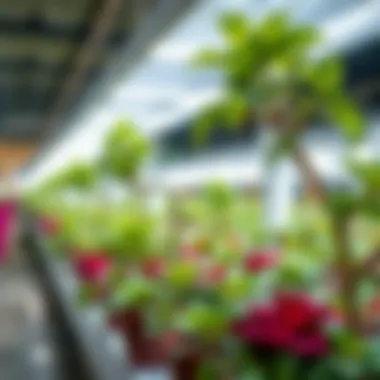
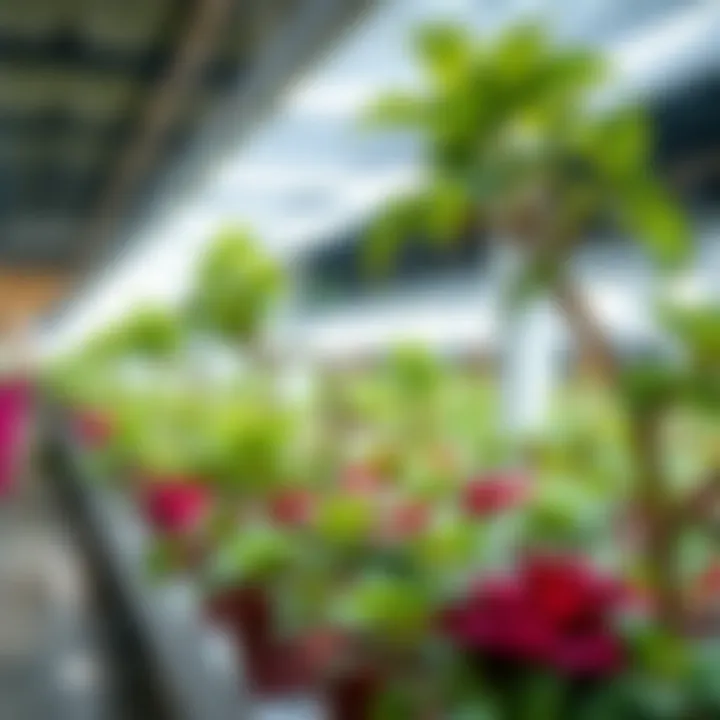
Automating Lighting Schedules
Embracing automation in your hydroponic setup can significantly ease the lighting management process. Automated lighting systems allow for precise control of light schedules, guaranteeing that your plants receive consistent exposure over time.
- Benefits of Automation:
- Consistency: Automation ensures that light cycles are reliable, reducing the chance of human error.
- Flexibility: With programmable timers, you can easily change schedules based on seasonal adjustments or different plant needs.
- Energy Efficiency: Automated systems can potentially lower energy costs by providing lighting only when needed.
By investing in automated lighting, hydroponic enthusiasts can ditch the early morning wake-ups, ensuring their plants get the right amount of light without any of the hassle. As the technology continues to evolve, these systems only become more user-friendly and efficient, making them an ideal choice for both novices and experienced growers alike.
Evaluating Plant Health Through Lighting
Understanding how plant lighting affects health is crucial for anyone immersed in hydroponics. When plants thrive under the right light conditions, they exhibit vibrant growth and produce bountiful yields. Conversely, inadequate or excessive lighting can lead to distress, impacting plant development adversely. This section emphasizes the significance of evaluating plant health through lighting and explores how to identify and address potential lighting-related problems effectively.
Identifying Issues Linked to Lighting
To maintain a flourishing hydroponic garden, recognizing symptoms directly caused by lighting conditions is vital. These signs serve as a detective’s tool, providing insights into the plant’s well-being.
Signs of Light Stress
When plants experience light stress, certain traits begin to surface. Leaves may become yellow or scorched, indicating either too much light or improper light spectrum. Some plants might not only appear droopy but also fail to reach their full potential—getting leggy in search of more balanced light.
One key characteristic of light stress is leaf curling, a significant indicator of either excessive intensity or incorrect light placement. For this article, discussing signs of light stress proves beneficial as it empowers growers to take corrective actions swiftly. Understanding these signs allows for timely intervention that can prevent long-term damage.
The unique feature of recognizing light stress lies in its direct correlation with plant growth and yield potential. By monitoring these symptoms, growers can adjust lighting conditions—either by reducing intensity, changing the spectrum, or altering the distance between the light source and the plants. This ensures optimal photosynthesis, thereby enhancing overall health in the hydroponics system.
Growth Patterns Analysis
Analyzing growth patterns can reveal much about how plants respond under varying lighting regimes. A plant exhibiting robust, thick stems and broad leaves is likely receiving the right amount and quality of light. On the flip side, stunted growth or unusual stretching can indicate insufficient light.
The key characteristic of growth patterns analysis rests in its emphasis on observational data. This approach often leads to more nuanced understanding among hydroponic farmers regarding specific plant reactions to light conditions. Such analysis is considered beneficial because it assists in creating tailored strategies for different plant species, optimizing their light requirements.
What sets this approach apart is its ability to link growth performance directly to specific lighting parameters. Understanding these relationships can pave the way for adaptations, helping growers refine their lighting setups for better yields. However, a downside is that variability in environmental conditions might complicate interpretations, making accurate assessments sometimes challenging.
In summary, evaluating light's effect on plant health goes beyond mere observation; it creates pathways for enhanced management strategies in hydroponics. Emphasizing the signs of light stress and growth patterns analysis can significantly impact the success of a hydroponic system, paving the way for sustainable and productive cultivation.
Advancements in Hydroponic Lighting Technology
As technology evolves, so does the potential for improving plant lighting techniques in hydroponics. Modern advancements have transformed the strategies that growers utilize, enhancing both efficiency and yield. Being aware of these developments makes it easier for farmers and enthusiasts to elevate their systems to new heights.
Smart Lighting Systems
Smart lighting systems represent a significant leap in hydroponic technology. These systems utilize intelligent controls that adapt lighting conditions based on various parameters. For example, sensors can adjust light intensity based on the natural light available or the growth stage of the plants. This kind of automation not only alleviates manual adjustments but also helps in optimizing energy use.
Key Features of Smart Lighting Systems:
- Remote Control: Users can manage settings from a smartphone or a computer, offering unparalleled convenience.
- Integration with Hydroponic Systems: Smart technology can work hand-in-hand with other environmental controls, such as humidity and nutrient delivery systems, creating a cohesive ecosystem.
- Data Analytics: With analytical tools, growers can track plant health and light exposure, leading to informed decisions that improve growth outcomes.
The efficiency gains not only save time but can also lead to reduced electricity costs and improved overall plant health.
Future Trends in Grow Lights
The future of grow lights in hydroponics is ripe with promise. Innovations are paving a path that diversifies options and enhances productivity. Here are several trends that are gaining traction:
- Full-Spectrum LEDs: While LEDs have already made waves, the advancement towards full-spectrum options allows for tailored wavelengths that can mimic natural sunlight more closely. This adaptability supports photosynthesis more effectively.
- Biophotonic Lighting: This cutting-edge approach integrates biological elements into the lighting system, aimed at harnessing specific light wavelengths known to trigger enhanced growth and flavor profiles in plants.
- Energy-Efficient Technologies: Emerging technologies emphasize energy efficiency by using less power while maintaining or improving output. It’s critical for growers to consider systems that align with sustainability goals, potentially lowering their ecological footprint.
"Investing in progressive lighting technologies may be the difference between a mediocre harvest and a bountiful yield."
As these advancements unfold, hydroponic growers must stay informed and consider how they can leverage this technology for their unique crops. The interplay of innovation and agricultural practices is set to define the future of hydroponics, allowing for greater food security and environmental responsibility.
Culmination
The subject of plant lighting in hydroponics is not just a peripheral detail; it stands at the very heart of successful hydroponic gardening. The intricate interplay between light and plant biology reveals that proper lighting can either be a boon or a bane. Ensuring that plants receive the exact spectrum, intensity, and duration they need is pivotal for achieving optimal growth and yield.
Summary of Key Points
- Importance of Light: The right type of light affects photosynthesis directly, impacting growth rates and overall plant health. Whether it's using LEDs, fluorescent, or HID systems, understanding the light spectrum is fundamental.
- Lighting Strategies: Tailoring lighting to plant stages, from nursery to harvest, demands attention. Each growth phase requires specific durations and intensities, which should be adjusted as the plants develop.
- Environmental Interactions: Temperature and humidity play significant roles in how effective lighting is. Managing these factors alongside lighting can further enhance plant health and productivity.
- Technological Advances: Smart lighting systems are emerging, making it easier to fine-tune light conditions automatically based on plant needs. This tech-savvy approach is potentially revolutionary for hydroponic farmers.
The Future of Plant Lighting in Hydroponics
As we look ahead, the future of plant lighting in hydroponics seems promising and full of potential. Advances in technology, like fully programmable lights that adapt to real-time growth conditions and needs, will become more common. Moreover, sustainability is becoming a pressing focus; energy-efficient light systems will be vital in minimizing the carbon footprint of hydroponic operations.
New research may uncover even more effective light spectrums tailored for various species of plants. As we gather more data on plant responses to different lighting scenarios, hydroponic systems could become tailored to an extent previously thought impossible. In short, staying abreast of these developments can not only lead to greater yields but can fundamentally alter how plants are grown in controlled environments.
"The future of hydroponic lighting is not just about brightness, it’s about precision and adaptability to the needs of the plant."
With an increasingly informed community of growers and more sophisticated light solutions, the landscape of hydroponics is rapidly evolving. Those who adapt will thrive, reaping the rewards of optimized plant growth and environmental stewardship.



